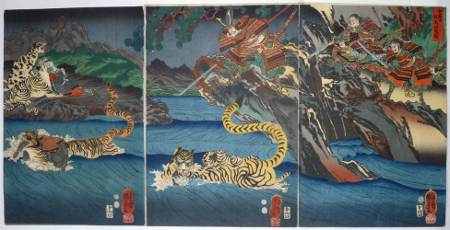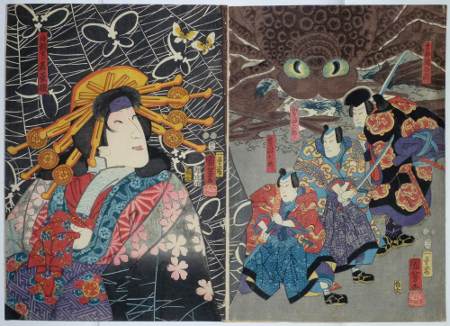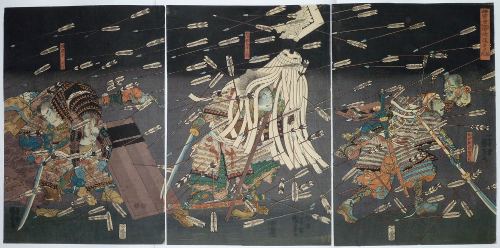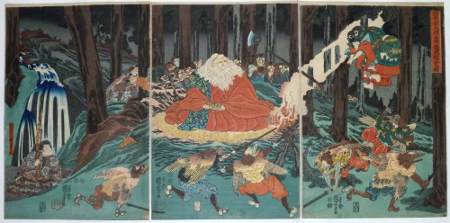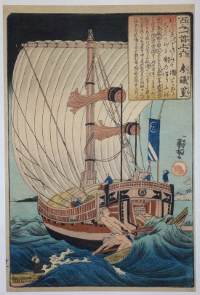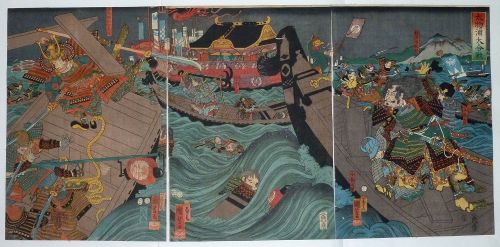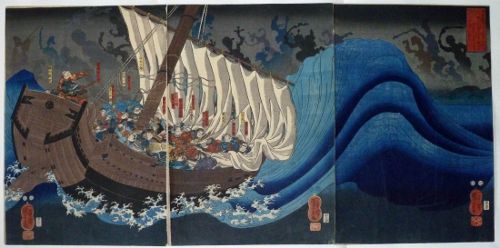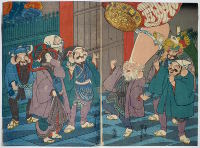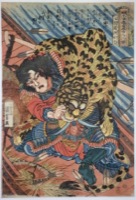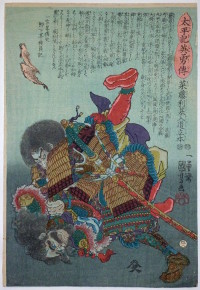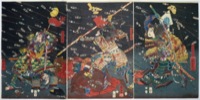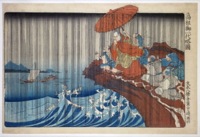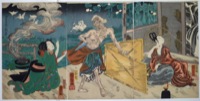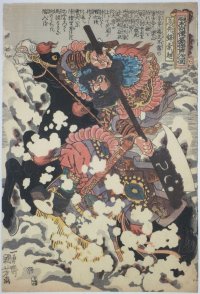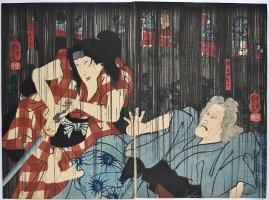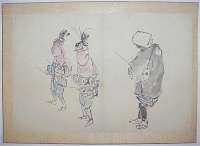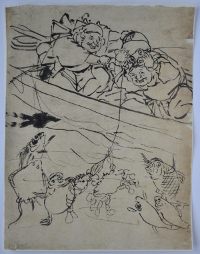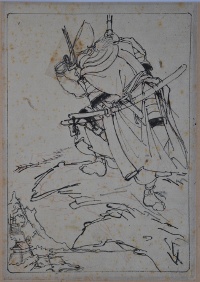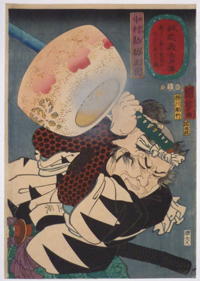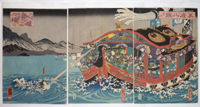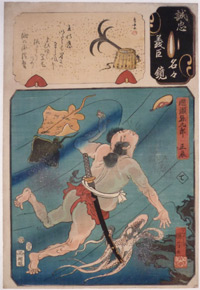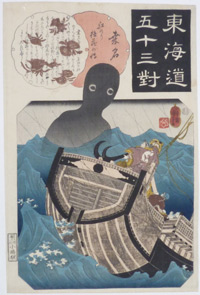Utagawa KUNIYOSHI (1797-1861)
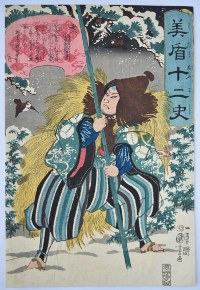
Click here to view image full size.
Yamamoto Kansuke striding through the snow. “Boar” from a set Mitate junishi, “Selection for the Twelve Signs.” Published by Ibaya Kyubei, c 1845. (Kansuke was famous for killing a giant boar in the snow.) Robinson S38.12.
Fine impression, colour and condition. Signed Ichiyusai Kuniyoshi ga.
Status: Sold
Utagawa KUNIYOSHI (1797-1861)
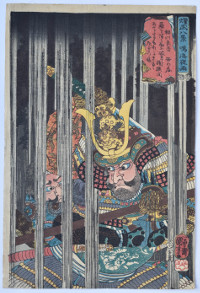
Click here to view image full size.
The death of the Daimyo Imagawa Yoshimoto (1519-60) by Oda Nobunaga during the battle of Okehazama which was fought at night during an intense downpour and was the culmination of the feud between the Imagawa and Oda clans. The battlefield is now a park and a national historical site. The best design from a set Yobu hakkei, “Military Brilliance of the Eight Views.” Each print relates to the famous Eight Views theme, in this case Narumi yau, “Night Rain at Narumi.” Published by Enshuya Hikobei, 1852.
Fine impression, colour and condition. Full size with extra paper left and top, which is unusual as these prints are normally trimmed from albums. Signed Ichiyusai Kuniyoshi ga.
Status: Sold
Utagawa KUNIYOSHI (1797-1861)
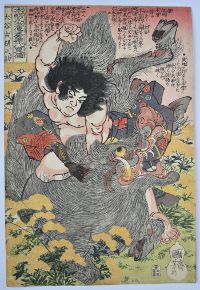
Click here to view image full size.
The fifteen year old Otani Furuinosuke killing a giant boar with his bare hands. From a set Honcho Suikoden goyu happyakunin no hitori, “One of the Eight Hundred Heroes of the Water Margin of Japan.” Published by Kagaya Kichiemon c 1831. This is the first edition: It was republished by Ibaya Sensaburo in 1845. Robinson S4a.14.
Fine impression and colour. Slight trimming at left, otherwise very good condition. Signed Ichiyusai Kuniyoshi ga.
Status: Sold
Utagawa KUNIYOSHI (1797-1861)
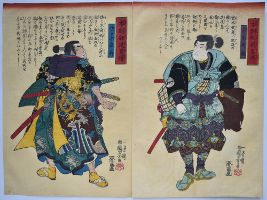
Click here to view image full size.
A complete diptych showing Miyamoto Musashi dressed for travelling looking across at Sasaki Kojiro who stands in profile with clenched fist. These two great swordsmen agreed to fight on April 13, 1612, on Ganryu Island off the coast of Bizen Province. The outcome was that Musashi killed Kojiro. From a set of prints Kendo ryaku den “Abridged Stories of Our Country’s Swordsmamship.” Published by Kadzusa-ya Iwazo, c. 1845-6. Robinson S37.16.18. The complete diptych is rare.
Very fine impression, colour and condition. Signed Ichiyusai Kuniyoshi ga.
Status: Sold
Utagawa KUNIYOSHI (1797-1861)
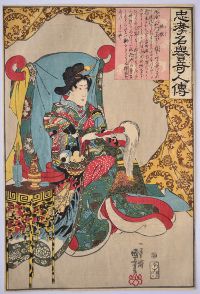
Click here to view image full size.
Jigoku Dayu, the “Hell Courtesan” from the set Chuko meiyo kijin den, “Stories of Remarkable Persons of Loyalty and High Reputation.” Published by Iseya Ichiemon or Enshuya Matabei (this design) 1845. Robinson S35.3. She was a courtesan who found enlightenment through the Buddhist monk Ikkyu. (The fly-whisk she holds denotes her enlightenment.) Sold to a brothel, she believed her misfortune was due to karma and is always depicted with robes depicting images of hell.
Very fine impression and colour. Very slight crinkling and trimmed close, otherwise fine condition. Signed Ichiyusai Kuniyoshi ga.
Status: Sold
Ichiyusai KUNIYOSHI (1797-1861)
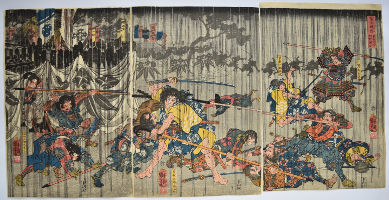
Click here to view image full size.
A triptych Fuji no sono Soga kyodai hommo o togeru zu. “Moor at the Foot of Mt. Fuji: Picture of the Soga Brothers Achieving their Avowed Wish.” Soga no Goro Tokimune and Soga no Juro Sukenari avenging the death of their father by killing Kudo Suketsune at his hunting encampment in pouring rain. Juro dies in the battle and Goro is killed later. Published by Yamaguchi Tobei, 1843-7.
Fine impression, colour and condition. Signed Ichiyusai Kuniyoshi ga.
Status: Sold
Utagawa KUNIYOSHI (1797-1861)
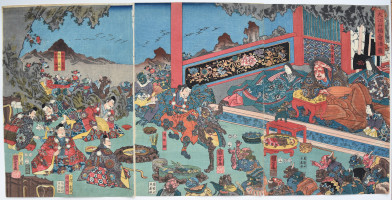
Click here to view image full size.
A triptych showing Shutendoji’s palace on Mount Oyeyama, Oyeyama fukujin shusei. Raiko (Minamoto no Yorimitsu) is charged by the Emperor Murakami with killing the evil Shutendoji who terrorizes the neighbourhood. He and his retainers infiltrate the castle and ply Shutendoji and his ogrish band with sake and dance for them. Eventually Shutendoji is so intoxicated he has to be carried to bed, whereupon Raiko and his followers attack and decapitate him. This is the episode most often depicted with the head flying through the air. Published by Kiya Sojiro, 1853.
Very good impression, colour and condition. Signed Ichiyusai Kuniyoshi ga.
Status: Sold
Utagawa KUNIYOSHI (1797-1861)
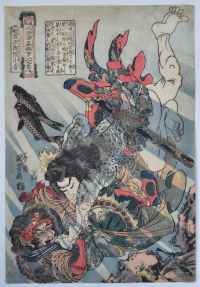
Click here to view image full size.
The heavily tattooed bandit Tanmeijiro Genshogo grappling with an adversary under water. One of the great designs from Tsuzoku Suikoden goketsu hyakuhachi-nin no hitori, “The Hundred and Eight Heroes of the Popular Suikoden, One by One.” Genshogo was famous for his tattoos and for the ability to stay under water for long periods. This large set and accompanying designs from the same period was a turning point in Kuniyoshi’s career. Published by Kagaya Kichibei, 1828-9. Robinson S2.69.
Fine impression and colour. Slight thinning of paper towards top; very slight centre fold and minimal soil at top, but otherwise fine condition. Alternate, later impressions lose the beautiful gradation in the water. Signed Ichiyusai Kuniyoshi ga.
Status: Sold
Utagawa KUNIYOSHI (1797-1861)
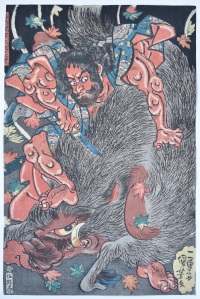
Click here to view image full size.
The brigand Saginoike Heikuro Masatora plunging a short sword into a giant boar. He is usually depicted battling a giant snake. Published c 1834-5 by Sanoya Kihei. Republished by Uedaya Kyujiro. Robinson S1c.17.
Very good impression and colour. The title label at extreme left edge trimmed and slight centre fold, otherwise good condition. Signed Ichiyusai Kuniyoshi ga.
Status: Sold
Utagawa KUNIYOSHI (1797-1861)
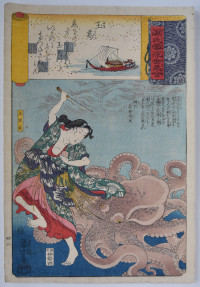
Click here to view image full size.
The best design from Genji kumo Ukiyoe awase, “Ukiyoe Comparisons of the Cloudy Chapters of Genji.” A set comparing famous warriors to the Chapters of the Genji Monogotari written by Lady Murasaki Shikibu (c 973-1025). This design is for Chapter 22, Tamakatzura. Shows the pearl diver, Tamatori-hime, who has reclaimed the precious pearl stolen by the Dragon King. She is pursued by a host of his aquatic retainers including a giant octopus before finally returning the jewel to her husband Fujiwara no Kamatari, albeit buried in her chest for safety and causing her death. A popular subject with Kuniyoshi who designed a number of other oban prints and triptychs on this subject. The Dragon King’s Palace can be seen beneath the waves in the background. Published by Iseya Ichibei, 1843-5.
Fine impression and colour. Slight crinckling in margins, otherwise very good condition. Signed Ichiyusai Kuniyoshi ga.
Status: Sold
Utagawa KUNIYOSHI (1797-1861)
Click here to view image full size.
A triptych showing Kato Kiyomasa (Watoni) and his henchmen watching Korean man-eating tigers carrying off their compatriots across a river. Watoni gunko toshu no zu. Hideyoshi sent Kiyomasa to Korea twice in 1592 and 1597. He is often depicted killing a man-eating tiger. Published by Yamaguchi-ya Tobei in 1855.
Very early fine impression with beautiful colour variation on the rocks at right. Fine colour. Slight edge crease near left edge of first sheet and imperceptible centre folds, otherwise very good condition. Signed Ichiyusai Kuniyoshi ga.
Status: Sold
Utagawa KUNIYOSHI (1797-1861)
Click here to view image full size.
An extremely rare diptych showing Princess Wakana (left) played by Bando Shuka I and the warriors Genkai Nadaemon played by Arashi Rikan III; Washizu Rokuro played by Arashi Rikaku II; Wachizu Shichoro played by Bando Takesaburo I. The play Shiranui monogatari, “The Tale of the White Embroiderer” was performed at the Kawarazaki Theatre, 2/1853. The story (from a late Edo novel) tells of the feud between Wakana and the Kikuchi clan who killed her family. She is rescued by a spider who gives her the power of spider magic which, with the aid of a spider scroll, enables her to conjure up a giant spider to assist her. Published by Kakumoto-ya Kinjiro. This is the only complete impression I have seen and I can only find one other recorded example (listed in the Kuniyoshi Project).
Fine impression and colour. Small edge binding holes, otherwise fine condition Signed Ichiyusai Kuniyoshi ga.
Status: Sold
Utagawa KUNIYOSHI (1797-1861)
Click here to view image full size.
Nanke yushi Shijo-nawate nite uchijini. The last stand of the Kusunoki clan at Shijo-nawate in 1348. Kusunoki Masatsura, shown on the far left propped against his fallen horse under a rain of arrows, continues his father’s struggle against the Ashikaga forces. Wada Shinbochi (Genshu) leads the way holding enemy heads followed by Masatomo with a battle standard. Their blue complexions anticipate their imminent demise. Published by Fujioka-ya Keijiro, 1851-2. Robinson T271.
Fine impression. One small backed wormhole on title, otherwise very good condition. Full size. Signed Ichiyusai Kuniyoshi ga.
Status: Sold
Utagawa KUNIYOSHI (1797-1861)
Click here to view image full size.
A triptych showing Ushiwaka Maru (Minamoto no Yoshitsune’s childhood name), attended by Kisanda, practising fencing with the karasu or “crow” tengu in a forest glade on Mt Kurama, north of Kyoto. His training in martial arts is being supervised by a white-bearded yamabushi tengu, Sojobo, King of the Tengu. (The yamabushi were followers of Shugendo – a shamanistic mountain ascetism.) Yoshitsune (1159-1189) is the best known Japanese warrior and a popular subject for Japanese artists and craftsmen. Famous for exploits such as the battle on Gojo Bridge with Benkei and the battle of Dan-no-ura. Published by Enshuya Hikobei, 1851-2. Robinson T264.
Fine impression. This is the first state with gradation on the rocks top left. Fine colour. Very good condition. Signed Ichiyusai Kuniyoshi ga.
Status: Sold
Utagawa KUNIYOSHI (1797-1861)
Click here to view image full size.
The stern of a large sailing-junk and a smaller vessel infront. A poem by Sangi Takamura (Ono no Takamura) from Hyaku-nin isshu, “The Hundred Poets” published by Ebine c 1838. Depending which story one reads, either Takamura, who was a customs official for ships trading to and from China, went missing on a mission or was reported for being an extortioner and banished to the Oki Islands. Either way, he was subsequently pardoned. One of the best designs from this fine set. Robinson S19.11 and illustrated in Robinson (1961), no. 59.
Fine impression. Very good colour. Remargined top and bottom, otherwise very good condition. Signed Ichiyusai Kuniyoshi ga.
Status: Sold
Utagawa KUNIYOSHI (1797-1861)
Click here to view image full size.
Daimotsu-no-ura o-kassen. A triptych showing the battle of Dan-no-ura. The clash between the Minamoto (Genji) clans and the Heike (Taira) clans happened in 24/3/1185 when the Taira were defeated by Yoshitsune. He is shown here on the left making his leap pursued by Noritsune. The Imperial barge is in the background. Published by Moriya Jihei, 1856. Robinson T337.
Fine impression and colour. Slight trimming, otherwise very good condition. Signed Ichiyusai Kuniyoshi ga.
Status: Sold
Utagawa KUNIYOSHI (1797-1861)
Click here to view image full size.
A triptych showing the ghosts of the Taira (Heike) warriors attempting to sink Yoshitsune’s ship off the coast of Settsu on his way to Shikoku. This is one of Kuniyoshi’s great designs – amongst the three or four best triptychs and is illustrated in numerous publications. The scene is the outcome of a great battle at Dan-no-ura where the Minamoto (Genji) clans clashed and defeated the Taira clans a few years earlier. The spirits of the drowned warriors rose up to seek revenge only to be pacified by Benkei reciting exorcisms with his rosary. Published 1849-52 by Enshuya Hikobei. Robinson T242. Rare.
Very good impression and colour although slightly mismatched blue on the first and second sheets. Very good condition. Full size. There appear to be three states of this design: The main difference being in the shape of the ghosts and lines in the waves only on the first state. In this (the second state) the ghosts lack some of the features that are on the first and a large spirit appears above the wave over the ship on the centre panel. The third state has further differences in the ghosts and lacks this figure. Also, the colour of the boat gets greyer. Signed Ichiyusai Kuniyoshi ga.
Status: Sold
Utagawa KUNIYOSHI ( 1797-1861 )
Click here to view image full size.
Kwatsuyemra Genshoshichi hiding under a tiger-skin in a boat under a hail of arrows. From Tsuzoku Suikoden goketsu hyaku-hachi-nin no hitori, “The Hundred and Eight Heroes of the Popular Suikoden, One by One.” Published by Kaga-ya Kichiyemon, c 1827-30. Robinson S2.40.
Fine impression and colour. Very good condition: completely untrimmed. Signed Ichiyusai Kuniyoshi ga.
Status: Sold
Utagawa KUNIYOSHI ( 1797-1861 )
Click here to view image full size.
Saito Toshimoto and a Chinese general struggling underwater. The second best design from Taiheiki yeiyu den, “Heroic Stories of the Taiheiki.” Published by Yamamoto-ya Heikichi, 1848-9. Robinson S62.31.
Extremely fine impression of the earliest printing. ( This is the best example I have seen of this design. ) Fine colour and condition. Signed Ichiyusai Kuniyoshi ga.
Status: Sold
Utagawa KUNIYOSHI ( 1797-1861 )
Click here to view image full size.
The last stand of the Kusunoki at Shijonawate, Shijonawate nite Nanke no eiyu taiteki o. Shows the final battle of Shijonawate in 1348 with Kusunoki Masatsura, the son of Kusunoki Masashige, under a deluge of arrows continuing his father’s struggle against the Ashikaga forces. This forms a 6-sheet composition with another triptych and Kuniyoshi also designed another triptych of the same subject. Published 1847. Unidentified publisher.
Very fine impression of the earliest printing. Very fine colour. Fine condition. Signed Ichiyusai Kuniyoshi ga.
Status: Sold
Utagawa KUNIYOSHI ( 1797-1861 )
Click here to view image full size.
The priest Nichiren standing on the rocky promontory at Reizan in Kamakura and having his prayers for rain answered. The event occurred in 1271. His disciples surround him and protect him from the deluge with a large umbrella. Bunei hachi Kamakura Reizan-ga-saki uki. The second best design from Koso [ Nichiren ] goichidai ryakuzu, “Illustrated Abridged Biography of the Founder.” Nichiren ( 1222 – 1282 ) was the founder of the Buddhist Nichiren sect ( Nichiren shu – Kuniyoshi being a follower ) and indeed the set of ten prints may have been commissioned to mark the 550th anniversary of his death. Published by Iseya Rihei c 1831.
Fine impression. Very good colour and condition. This design is notorious for having the umbrella trimmed off and/or the title in right margin. The printer has compensated for this by printing close to the left border. Signed Ichiyusai Kuniyoshi ga.
Status: Sold
Utagawa KUNIYOSHI ( 1797-1861 )
Click here to view image full size.
A triptych showing the old hag of Hitotsuya in the dilapidated house on Adachi Moor. The morbid story tells of a woman who developed cannibalistic habits for the lord of the district who required the blood of babies or young women. The hag menacies a young girl while Kannon ( to the right ), the goddess of compassion, looks on. In fact these are life-like dolls ( iki-ningyo ). There were popular exhibitions of these dolls during the mid 1850s to the late 1860s. Leading exponents being Yasumoto Kamehachi and Matsumoto Kisaburo. The latter had an exhibition in Asakusa Okuyama in 1855 and this might have been one of the exhibits. Kuniyoshi designed a number of diptychs and triptychs showing various exhibits of these dolls including others on this subject. Published 2/1855 by Yamaguchiya Tobei.
Very good impression, colour and condition. Signed Ichiyusai and Cho-o-ro Kuniyoshi ga.
Status: Sold
Utagawa KUNIYOSHI ( 1797-1861 )
Click here to view image full size.
Kyusempo Sakucho at the battle of Peking from Tsuzoku Suikoden goketsu hyaku-hachi-nin no hitori, “The Hundred and Eight Heroes of the Popular Suikoden, One by One.” Shows the brigand wielding a huge axe and plunging through deep snow on his horse. Published by Kaga-ya Kichiyemon, c 1827-30. Robinson S2.44.
Very good impression and colour. Slight trimming, otherwise very good condition. Signed Ichiyusai Kuniyoshi ga.
Status: Sold
Utagawa KUNIYOSHI (1797-1861)
Click here to view image full size.
A diptych showing the actors Bando Shuka (left) as O-kaji, wife of Danshichi, with sword drawn attacking Seki Sanjuro III as the old hag, wife of Giheiji of Mikawa-cho in pouring rain. From the play Shinzo Tsurifune kidan performed at the Ichimura theatre, 5/1852. Published by Kakumotoya Kinjiro. Kuniyoshi designed another version of this play in the same year for another publisher.
Fine impression and colour. Very good condition. Signed Ichiyusai Kuniyoshi ga.
Status: Sold
Utagawa KUNIYOSHI (1797-1861)
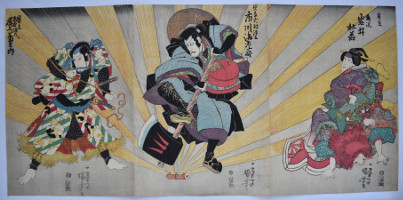
Click here to view image full size.
A mitate (imaginary) triptych showing, from left to right: Onoe Kikugoro III as Takehara Genpachi; Ichikawa Ebizo V as Omura Gengo; Iwai Tojaku as Fujinami. The actors surrounding a handscroll that is emitting strong bands of light. Published by Edoya Matsugoro, c. late 1830s.
Fine impression and colour. Album backing and joined sheets, otherwise fine condition. Signed Ichiyusai Kuniyoshi ga.
Status: Sold
Utagawa KUNIYOSHI (1797-1861)
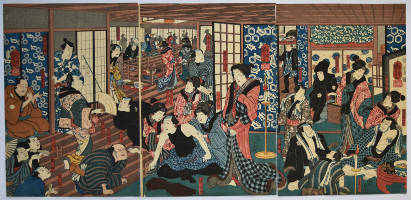
Click here to view image full size.
An interesting and rare Kuniyoshi triptych showing actors relaxing in a busy teahouse. In fact this group appeared in the play Sumidagawa tsui no kagamon performed at the Ichimura-za Theatre from the 3/3/1852. Left sheet: Suzuki Mondo just stepping into the room dressed in a blue and white yukata played by Sawamura Chojuro V. Other actors are Nakamura Kanemon , Nakamura Kantaro and Arashi Jitohachi III. Centre sheet: The courtesan Shiraito of the Hashimoto-ya standing right played by Bando Shuka I. Another actor Nakamura Kamenojo. Right sheet: The thug Tsukubane Sanpei seated holding a cup played by Otani Tomoemon IV and Oyaso, Mondo’s wife, seated by an hibachi played by Onoe Kikujiro II. Another actor being Bando Matataro. Published by Yamaguchiya Tobei, 1852.
Very good impression, colour and condition. Signed Ichiyusai Kuniyoshi ga.
Status: Sold
Utagawa KUNIYOSHI (1797-1861)
Click here to view image full size.
Three New Year drummers; two with lion (shishi) masks. Sumi and colour on paper, lightly laid onto card. 24.2 x 36.2 cms; 9.5 x 14.25 inches.
In good condition. Unsigned but from a group, one of which bore full signature.
Status: Available
Utagawa KUNIYOSHI (1797-1861)
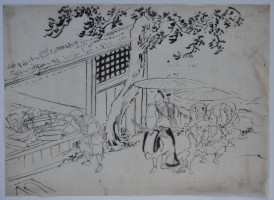
Click here to view image full size.
An original oban (10.5 x 15 in; 26.75 x 38 cms) preparatory drawing, sumi on thin paper, for an unpublished set. Shows a warrior and attendants, one of whom is being handed a parcel of scrolls (Gohonzon ?) by a priest in a nearby hut. Possibly intended for a set based on incidents in the life of Nichiren. Ex Julius Kurth collection (1870-1949. A German priest and scholar who published many books and papers on Japanese prints and Egyptian and Near Eastern art.) Sold “as is” but in generally good condition.
Status: Sold
Utagawa KUNIYOSHI (1797-1861)
Click here to view image full size.
An original sumi drawing showing the two gods of good luck, Ebisu and Daikoku, fishing from a boat. A variety of sea creatures can be seen in the water. Ebisu’s fishing line has caught an octopus which has landed on Daikoku’s head. 12 x 9.25 in; 30.5 x 23.5 cms. Laid onto Japanese paper. Sold “as is” with imperfections.
Status: Sold
Utagawa KUNIYOSHI (1797-1861)
Click here to view image full size.
An original drawing in sumi with light red under-drawing, 9.75 x 6.75 in; 24.7 x 17.2 cms, on thin paper laid onto card. Shows a general looking down on a castle. Slight foxing. Sold “as is.” Ex Tikotin collection, seal bottom right.
Status: Sold
Utagawa KUNIYOSHI (1797-1861)
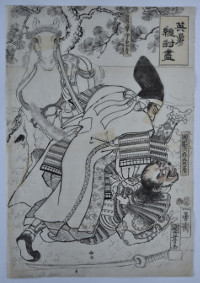
Click here to view image full size.
A fine original sumi drawing (hanshita-e) of oban size for an unpublished set: Eiyu kumiuchi zu, “Collection of Heroes in Combat.” Has a date seal for 1856. Sumi and light colour with pentimenti on thin paper. Shows the protagonists Satsuma no Kami Tadanori, a famous general of the Taira Clan, in combat with Okabe Rokuyata Tadasumi of the Minamoto Clan during the Genpei wars of 1180-1185.
In extremely good condition. Signed Ichiyusai Kuniyoshi ga. Rare.
Status: Sold
Utagawa KUNIYOSHI (1797-1861)

Click here to view image full size.
A fine original sumi drawing (hanshita-e) of oban size for an unpublished set, c. 1856. Sumi and light colour with extensive pentimenti on thin paper. Shows two samurai in combat. In extremely good condition.
Signed Ichiyusai Kuniyoshi ga. Rare.
Status: Sold
Utagawa KUNIYOSHI (1797-1861)

Click here to view image full size.
A fine original sumi drawing (hanshita-e) for an unpublished print for the set Tokaido gojusan tsui, “Fifty-three Parallels for the Tokaido Road.” The set was published by various publishers in 1845-6 and was a collaboration with Kunisada and Hiroshige. Sumi on thin paper. This is a design for the lower half of the oban print, the top half having the title and a panel with the name of the post-station. Shows Yamato Takeru no Mikoto. A legendary prince, son of the Emperor Keiko. Shown here with his retainers.
In extremely good condition. Provenance: Purchased from me in 21/11/1975. Rare.
Status: Available
Utagawa KUNIYOSHI (1797-1861)
Click here to view image full size.
The ronin Nakamura Kansuke Masatatsu dodging a brazier of hot ash. The best design from a fine set of twelve half length portraits of the forty-seven ronin: Seicho gishi shozo, “Portraits of Faithful Samurai of True Loyalty.” The depictions borrow strongly from western portraiture including imitation western script in the green border of the title cartouche. It is not necessary to repeat the story here as it is the best known Japanese tale. Published by Sumiyoshiya Masagoro, 12/1852.
Fine impression, colour and condition. Full size and the falling ash from the brazier represented by sprayed gofun ( slight loss ). The printing on this set is exceptional with details such as the sword blades and title cartouches burnished. Signed Kuniyoshi ga.
Status: Sold
Utagawa KUNIYOSHI (1797-1861)
Click here to view image full size.
A triptych showing Koman, the widowed daughter of a Lake Biwa farmer, swimming with the white banner of the Genji in her teeth towards the Taira barge of Munemori. On being picked up and finding where she was she jumped overboard but not before Sanemori cut her arm off with the banner wrapped round it. For the full story see Pointers And Clues To The Subjects Of Chinese And Japanese Art, Sampson Low Marstone & Co. Ltd., Will Edmunds, 1934, p. 451. Published By Iseya Ichibei, 1846.
Very fine impression, colour and condition. Full size. Signed Ichiyusai Kuniyoshi ga.
Status: Sold
Utagawa KUNIYOSHI (1797-1861)
Click here to view image full size.
A triptych showing Raiko attacking the Shuten-doji. A well know myth covered by numerous artists of all periods. Shuten-doji, “Great Drunken Boy” had great strength and atrocious habits, plundering the countryside around his stronghold on Oyeyama, “Devil’s Mountain.” The Emperor Murakami, losing patience, ordered Raiko to put an end to his exploits with the aid of a magic cap and poisoned sake. Raiko and his main retainers: Sakata no Kintoki, Usui no Sadamitsu, Watanabe no Tsuna, and Urabe no Suyetake stupefied the enormous hulk that was Shuten-doji and decapitated him. Depictions of this scene usually show the head flying through the air and it often has a more gruesome appearance with fangs and horns. Raiko returned in triumph with the head to Kyoto. One of Kuniyoshi’s best designs. Published c 1851-2 by Amatsu. Robinson T261. Rare.
Fine impression and colour. Some oxidation as usual. Slight trimmimg, otherwise very good condition. Signed Ichiyusai Kuniyoshi ga.
Status: Sold
Utagawa KUNIYOSHI (1797-1861)
Click here to view image full size.
The ronin Mase Magokuro Masatoki swimming to the surface surrounded by two rays and an octopus. His sword is loosely strapped around his waist. From a set Seichu gishin meimei kagami, “Mirror of the True Loyalty of the faithful Retainers, Individually.” Published by Iseya Isaburo, 1857. Robinson S90.41. A fine design.
Fine impression and colour. Extensive sprayed gofun ( oxidised ). Light discolouration top right, but otherwise good condition. Signed Ichiyusai Kuniyoshi ga.
Status: Sold
Ichiyusai KUNIYOSHI (1797-1861)
Click here to view image full size.
The apparition of the Sea Monk, Umibozu, looming above the sailor Kawanaya Tokuzo. The best design from Tokaido gojusan tsui, Station 41, Kuwana. The legend has it that Tokuzo, against the advice of his peers, went to sea on the last day of the year. He subsequently experienced huge seas and the monster who demanded to know what was the most horrible thing he knew. He replied that his profession was the most horrid. Satisfied, the creature descended into the Stygian gloom and the storm abated. Published by Kojima-ya Jubei, c. 1845. Illustrated in Robinson, Kuniyoshi, HMSO, 1961, no. 49.
Fine, early impression with the light blue on the sea. Fine colour. Expert remargin at bottom but retaining black border. Signed Ichiyusai Kuniyoshi ga.
Status: Sold
